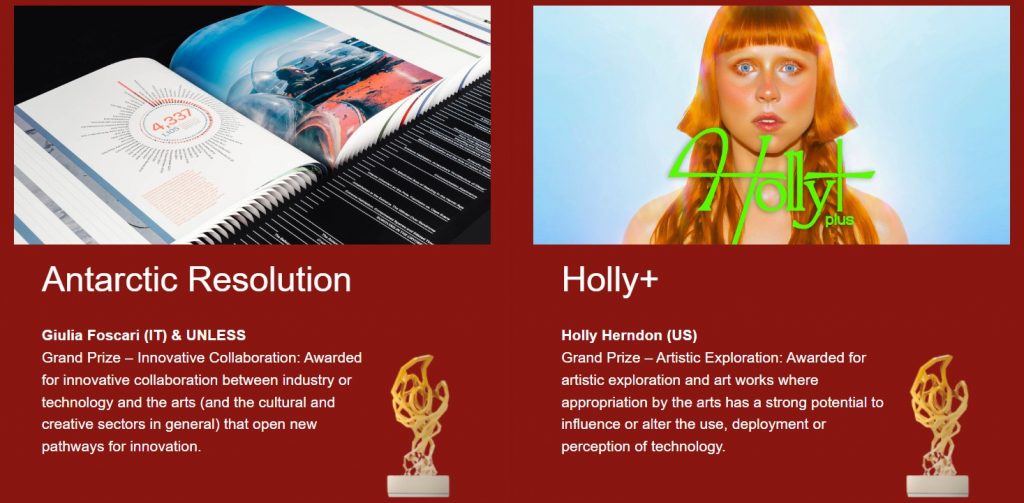S+T+ARTS Prize 2022: who are the winners?
One key element of the STARTS Initiative is a prestigious award generously endowed with €40,000 in prize money: each year, a yearly competition is held to single out for recognition innovative projects at the nexus of science, technology and the arts, that have what it takes to make a significant impact on economic and social innovation.
The two STARTS prize-winners each receive €20,000 and are prominently featured at Ars Electronica and other events of the consortium partners BOZAR, Waag, INOVA+, T6 Ecosystems, French Tech Grande Provence and Frankfurter Buchmesse.
This year, 1499 applications from 56 countries, were directly submitted to the S+T+ARTS Prize 2022.
The projects that the jury chose to highlight in both their nominations and awards, deal with environmental & digital commons: looking at the environment beyond the dominant visible spectrum, revealing different interests, tensions, or international rivalries; and seeking to make novel technological, ecological and business solutions truly inclusive and sustainable for society.
1st Grand Prize
The first Grand Prize was awarded to Antarctic Resolution, by Giulia Foscari / UNLESS: for artistic exploration into how appropriation through the arts has a strong potential to influence or change the use, deployment, or perception of technology.
What happens in Antarctica does not stay in Antarctica.
Accounting for 10% of the landmass, 70% of the freshwater, and 90% of the ice of Planet Earth, Antarctica is the largest repository of scientific data on our climate history—essential to inform crucial environmental policies—and the greatest menace to global coastal settlements threatened by the rise in sea levels induced by anthropogenic global warming.
While the future of our planet depends, to a great extent, on the fate of the Antarctic, our seventh continent is collectively neglected. Mostly thought of as our last wilderness, a far-away pristine landscape, Antarctica is a contested territory that conceals also resources that might prove irresistible in a world with an ever-increasing population and potential resource shortages triggered by geopolitical unrest.
Antarctic Resolution was conceived by Giulia Foscari / UNLESS to catalyse global attention to one of our few Global Commons and create a constituency for our only continent without an indigenous population, with the ambition of contributing to the protection of the Antarctic, and in turn, of our own species.
Developed as a transnational and multidisciplinary collective effort, Antarctic Resolution was launched on occasion of the bicentenary of the first recorded human landing on the continent in the format of a 1000-page volume published by Lars Müller Publishers and authored by the 150 leading world Antarctic experts. The encyclopedic publication focuses on the continent’s unparalleled scientific potential, contemporary geopolitical significance, and extreme inhabitation model. Alongside rigorous academic research, the volume presents an unprecedented visual portfolio including photographic essays, data-driven infographics, cartographies, and architectural drawings. Building upon the power of the arts to catalyze global action and accelerate the process of data democratization, the research was presented in homonymous site-specific exhibitions within the Central Pavilion of the 17th International Architecture Biennale (Venice, Italy) and at the Museo Nacional Thyssen-Bornemisza on the occasion of the 30th anniversary of the Protocol on Environmental Protection to the Antarctic Treaty (Madrid, Spain).
2nd Grand Prize
The second Grand Prize was awarded to Holly+, by Holly Herndon, Mathew Dryhurst, Herndon Dryhurst Studio, for an innovative collaboration between industry / technology and the arts (and more broadly the cultural and creative sectors), opening new avenues for innovation.
Holly+ is Holly Herndon’s digital twin. She is using machine learning to create freely available online instruments and tools that encourage anyone to create art with her AI voice and image, as part of an expansive art and research project experimenting with the economy around her digital likeness.
The first Holly+ instrument allowed anyone to upload polyphonic audio to http://holly.plus and receive a version sung back in Holly’s voice. There have since been more instruments made, allowing for people to upload scores for her voice to sing, and for people to perform in her voice in real time (premiered at Sonar 2021). These instruments so far have been created in a joint collaboration between Herndon Dryhurst Studio, Never Before Heard Sounds (NYC), and Voctro Labs (Barcelona).
This new model for the stewardship of digital identities challenges common pessimistic narratives around “deepfakes” while addressing relevant concerns. Hundreds of people now hold partial governance of Holly’s digital twin as part of Holly+ DAO, which provides an incentive to vote on appropriate usage. Once approved, any art made with her voice can be verified by tracing its provenance back to the public Holly+DAO identity. This means that if a piece of media is created that is offensive or uncharacteristic, it can easily be dismissed unless approved by voting stewards.
In addition to the two winning projects, the jury identified 10 Honorary Mentions and another 18 Nominations from all the submissions.
Discover all the winners and read more about each project!

Subscribe to our newsletter not to miss any news about the S+T+ARTS community.


